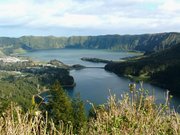|
|
Sao_Miguel_satellite_photo-NASA.jpg
Sao_Miguel-the_green_island.JPG
São Miguel Island (Portuguese for Saint Michael), also known as the "Green Island," is the largest (759 km2; 293 sq mi) and most populous of the Azores Islands. The island has around 140,000 inhabitants, most of whom live in the municipality of Ponta Delgada, the most populous place in the islands. The Sete Cidades lagoons are formed by two craters that have a perimeter of 12 km (7.5 miles). The name of inhabitants are known as Micaelense.
| Contents |
Geography
São Miguel is 90 km from east to west, and between 8 and 15 km wide. Named the "Green Island", São Miguel is largely covered with fields and meadows in the lowlands, and laurisilva forests in the hills. Geysers and hot springs (caldeiras) are spread over the island, which is composed of an old solid mass that strecthes from Povoação to Nordeste. São Miguel has 3 stratovolcanoes and caldeiras, Sete Cidades, Fogo and Furnas. The volcanic masses are connected between the alignments of the cone-like mass that are made up of peaks.
The peak areas which is located between Sete Cidades and Fogo composes of 270 monogenic volcanoes. They are primarily made up of basaltic cones which was fomed during Strombolian and Hawaiian-style eruptions. It is the most recent area oin the island. The youngest volcanoes are relavitely well dated. It possibly countes 19 eruptions which have occurred 3,000 years ago. One eruption was historical and was known as Fogo 2 occurred in 1652.Furnas_sao_miguel.jpg
Cities and towns:
Mosteiros_sao_miguel.jpg
Municipalities
History
São Miguel was the first of the Azores islands to be colonised, by the Portuguese in 1433.
Originally, São Miguel was two islands. In 1563, the island was joined by a volcanic eruption.
External links
fr:São Miguel nl:São Miguel pt:Ilha de São Miguel sv:São Miguel

